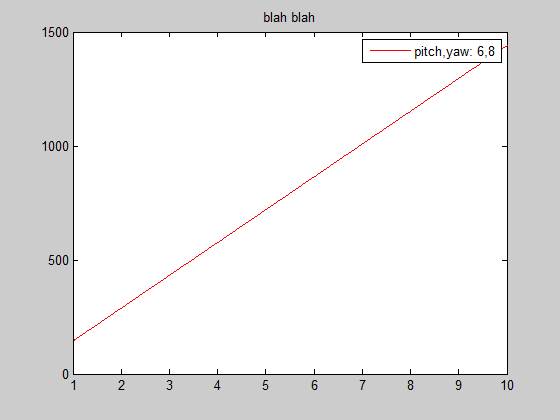Dynamic Legend (Updates in every recursion)
I got a for i=1:15. Inside I generate a variable d=1:0.01:10, which is the x'x axis and based on this, I create a continuous function F(d) which has 2 unique variables pitch and yaw. I then plot this using different colors in every recursion using cmap = hsv(15);. So then it is:
d=1:0.01:10;
cmap = hsv(15);
for i=1:15
pitch = unidrnd(10);
yaw = unidrnd(10);
for j=1:length(d)
F(j) = d(j)*3*pitch*yaw; %// some long calculation here
end
p1 = plot(d,F,'Linewidth', 1.0);
title ('blah blah')
set(p1, 'Color', cmap(i,:));
hold on;
legend (['pitch,yaw:', num2str(pitch) num2str(yaw)])
end
hold off;
This code updates the unique pitch, yaw values in every recursion (without space between them so it is kind irritating) but fails to:
- Apply the proper color, visible in the figure.
- Hold the color from the previous iteration and the values of
pitch,yaw.
Answer
Semidocumented Solution
Adding lines to a legend in a loop can be accomplished with "dynamic legends", as described on undocumentedmatlab.com.
The idea is to replace the legend command with:
legend('-DynamicLegend');
Then update the plot command with a DisplayName parameter:
plot(d,F,'Linewidth',1.0,'DisplayName',sprintf('pitch,yaw: %d,%d',pitch,yaw));
Then plots that are added to the axes get added to the legend:

If semi-documented features are not your cup of tea, use the DisplayName trick and simply toggle the legend off/on. That is, instead of -DynamicLegend:
legend('off'); legend('show');
A different variation that does not use either DisplayName or -DynamicLegend is to delete and recreate the legend with an array of stored strings.
Official Solution
The official solution recommended by MathWorks it so grab the existing legends` line handles and manually update the legend with those handles. This is pretty painful by comparison to the dynamic legend solution above:
% Get object handles
[LEGH,OBJH,OUTH,OUTM] = legend;
% Add object with new handle and new legend string to legend
legend([OUTH;p1],OUTM{:},sprintf('pitch,yaw: %d,%d',pitch,yaw))
